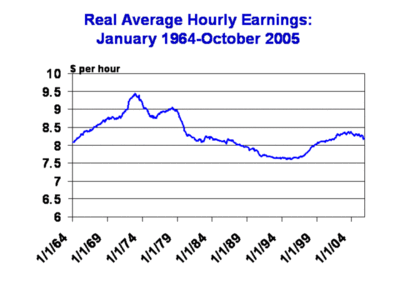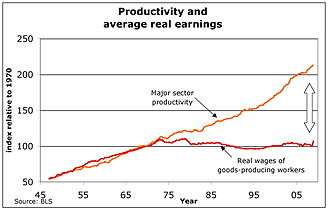Real wages


Real wages are wages adjusted for inflation, or, equivalently, wages in terms of the amount of goods and services that can be bought. This term is used in contrast to nominal wages or unadjusted wages.
Because it has been adjusted to account for changes in the prices of goods and services, real wages provide a clearer representation of an individual's wages in terms of what they can afford to buy with those wages - specifically, in terms of the amount of goods and services that can be bought. However, real wages suffer the disadvantage of not being well defined, since the amount of inflation (which can be calculated based on different combinations of goods and services) is itself not well defined. Hence real wage defined as the total amount of goods and services that can be bought with a wage, is also not defined. This is because changes in the relative prices of goods and services will change the financial comparability of various bundles of goods and services.
Despite difficulty in defining one value for the real wage, in some cases a real wage can be said to have unequivocally increased. This is true if: After the change, the worker can now afford any bundle of goods and services that he could just barely afford before the change, and still have money left over. In such a situation, real wage increases no matter how inflation is calculated. Specifically, inflation could be calculated based on any good or service or combination thereof, and real wage has still increased. This of course leaves many scenarios where real wage increasing, decreasing or staying the same depends upon how inflation is calculated. These are the scenarios where the worker can buy some of the bundles that he could just barely afford before and still have money left, but at the same time he simply cannot afford some of the bundles that he could before. This happens because some prices change more than others, which means relative prices have changed.
The use of adjusted figures is used in undertaking some forms of economic analysis. For example, to report on the relative economic successes of two nations, real wage figures are more useful than nominal figures. The importance of considering real wages also appears when looking at the history of a single country. If only nominal wages are considered, the conclusion has to be that people used to be significantly poorer than today. However, the cost of living was also much lower. To have an accurate view of a nation's wealth in any given year, inflation has to be taken into account and real wages must be used as one measuring stick.
An alternative is to look at how much time it took to earn enough money to buy various items in the past, which is one version of the definition of real wages as the amount of goods or services that can be bought. Such an analysis shows that for most items, it takes much less work time to earn them now than it did decades ago, at least in the United States.[1]
Real wages are a useful economic measure, as opposed to nominal wages, which simply show the monetary value of wages in that year.
Example
Consider an example economy with the following wages over three years. Also assume that the inflation in this economy is 2% per year:
- Year 1: $20,000
- Year 2: $20,400
- Year 3: $20,808
Real Wage = W/i (W= wage, i= inflation, can also be subjugated as interest).
If the figures shown are real wages, then wages have increased by 2% after inflation has been taken into account. In effect, an individual making this wage actually has more ability to buy goods and services than the previous year. However, if the figures shown are nominal wages then real wages are not increasing at all. In absolute dollar amounts, an individual is bringing home more money each year, but the increases in inflation actually zeroes out the increases in their salary. Given that inflation is increasing at the same pace as wages, an individual cannot actually afford to increase their consumption in such a scenario.
Trends
Following the recession of 2008 real wages globally have stagnated[2] with a world average real wage growth rate of 2 percent in 2013. In Africa, Eastern Europe, Central Asia, and Latin America have all experienced real wage growth of under 0.9 percent in 2013. Whilst the developed countries of the OECD have experienced real wage growth of 0.2 percent in the same period. Asia has consistently experienced strong real wage growth of over 6 percent from 2006 to 2013.[3] The International Labour Organisation has stated that this has resulted in "a declining share of GDP going to labour while an increasing share goes to capital, especially in developed economies."[2]
The Economic Policy Institute has blamed "intentional policy choices" by governments for real wage stagnation in this period. Stating "the abandonment of full employment as a main objective of economic policymaking, declining union density, various labor market policies and business practices, policies that have allowed CEOs and finance executives to capture ever larger shares of economic growth, and globalization policies"[4] have resulted in stagante real wages in a time of increasing productivity.
United States
Real wages in the United States, have stagnated since the mid-1970s[5] contrary to expectations that real wages should raise in line with increases in productivity.[6] Between 1973 and 2013 productivity in the United States grew by 74% whilst compensation for workers grew by 9% in the same period.[6] The stagnation of real hourly wages has resulted in a Middle-class squeeze as increases in inflation and the cost of living exceeds the growth of real wages for members of the middle and lower classes.[7][8]
European Union
The countries of Belgium, France, Germany, Italy and the United Kingdom have experienced strong real wage growth following European integration in the early 1980s.[6]
See also
References
- ↑ "Time Well Spent: The Declining Real Cost of Living in America" by W. Michael Cox and Richard Alm, pp. 2-24 of the 1997 Annual Report of the Federal Reserve Bank of Dallas.
- 1 2 "Global wage growth stagnates, lags behind pre-crisis rates". International Labour Organisation. 5 December 2014. Retrieved 11 June 2016.
- ↑ "Comparing how wages have changed in different regions of the world". 2014-12-05. Retrieved 2016-07-10.
- ↑ Mishel, Lawrence (6 January 2016). "Causes of Wage Stagnation". Economic Policy Institute. Retrieved 11 June 2016.
- ↑ WHITE, GILLIAN (25 February 2015). "Why the Gap Between Worker Pay and Productivity Is So Problematic". The Atlantic. Retrieved 11 June 2016.
- 1 2 Anderson, Richard G. (2007). "How Well Do Wages Follow Productivity Growth?" (PDF). Economic Synopses. Federal Reserve Bank of St. Louis. 7. Retrieved 11 June 2016.
- ↑ Gabler, Neal. "The Secret Shame of Middle-Class Americans Living Paycheck to Paycheck". Retrieved 2016-07-10.
- ↑ Erickson, Jennifer (24 September 2014). "The Middle-Class Squeeze". Center for American Progress. Retrieved 11 June 2016.